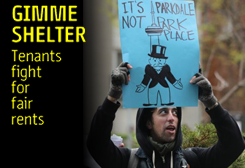RENTERS' RISING
We need to take sides
in tenants’ rent strike

Quick take
- More than 100 tenants on 71, 75 and 79 Thorncliffe Park Drive in Toronto are on strike. They refused to pay rent in May. They expect more tenants will join them come June
- The Ontario rent increase guidelines for 2022 and 2023 were 1.2 and 2.5 per cent, respectively. The buildings’ owners want much, much more.
- The landlords are asking for an above guideline increase (AGI):
- 4.2 per cent in 2022—close to 400% more than the guideline
- 5.0 per cent in 2023—a 100% increase over the guideline
- The increases the landlords want would increase the average rent by more than $1,500 a year. That’s 2.5 weeks of full-time work at the current Ontario minimum wage. Tenants would also be required to pay hundreds of dollars in retroactive rents increase for 2022.
- Landlords win big time. The same AGI application can cover hundreds of units. Future rent increases are compounded on top of AGIs, generating extra revenues for years.
- If tenants can’t bear the financial burden and leave, landlords raise rents by as much as they want — in Ontario (and other provinces) there are no rent controls on vacant units. In either case, the landlords win.
- The AGI was the final straw. More than 100 tenant families in the three buildings went on a rent strike, demanding that the AGI be dropped.
Tenant organizing is not new, but whenever it gains momentum, it exposes the class conflict that underpins housing debates, pushing people to pick a side.
Which side are you on?
* * * * * * * * * * * * * * * * * * * * * * * * * * * * * * *
Full text
* * * * * * * * * * * * * * * * * * * * * * * * * * * * * * *
We need to take sides
in tenants’ rent strike
Real estate giant acts within the limits of the law to maximize returns on investments while tenant families are squeezed to pay the rent on time.
By Ricardo Tranjan
Toronto Star Contributor
Sat., June 3, 2023
Faced with skyrocketing rents and the endless housing debates that accomplish little, organized tenants are going on rent strike. More than 100 tenants on 71, 75 and 79 Thorncliffe Park Drive refused to pay rent in May. Come June 1, more tenants and more buildings may follow suit.
Tenant organizing is not new, but whenever it gains momentum, it exposes the class conflict that underpins housing debates, pushing people to pick a side.
The Ontario rent increase guidelines for 2022 and 2023 were 1.2 and 2.5 per cent, respectively. For Starlight Investments, the real estate giant overseeing financial assets, including these and other buildings, for the Public Sector Pension Investment Board (PSP), one of Canada’s largest pension funds, 3.7 per cent over two years wasn’t enough. The company applied for an above guideline increase (AGI) that would raise rents by around 4.2 per cent in 2022 and five per cent in 2023, with the exact increase varying across units. The justification: recent renovation costs.
In other industries, service providers absorb the cost of preserving and improving their assets, but in Ontario (and other provinces), landlords get the special treatment of passing these costs onto tenants on top of rents. A sweet deal they have been cashing on.
Analyses by the Wellesley Institute and RenovictionsTO have found a remarkable increase in AGI applications over the past years.
For landlords, AGIs pay off. The same application can cover hundreds of units. Future rent increases are compounded on top of AGIs, generating extra revenues for years. If tenants can’t bear the financial burden and leave, landlords raise rents by as much as they want — in Ontario (and other provinces) there are no rent controls on vacant units. In either case, the landlords win.
For tenants, AGIs come as a sucker punch.
Tenants don’t get to choose whether a renovation is necessary. They don’t get to choose which renovation should be done first. They don’t get to choose how much is spent. Yet, they must foot the bill. Even if they can’t.
According to 2021 Census data, 37 per cent of tenants at 75 and 79 Thorncliffe Park Drive spend more than 30 per cent of their income on rent, or too much, using the standard definition of housing affordability. Another 42 per cent live in units that are too small for the size of their families — likely to keep rent costs low. (71 Thorncliffe Park Drive is in a separate census area, with similar statistics.)
In the second year of the pandemic, workers in these buildings were less than half as likely to work from home as average Torontonians. Back then, they were called essential workers.
Census data also shows that 32 per cent of them leave for work between 12 p.m. and 4:59 a.m. As any parent will tell you, unconventional working hours take a toll.
The AGI was the straw that broke the camel’s back.
Based on average rents in that part of town, average increases would add to more than $1,500 a year. That’s 2.5 weeks of full-time work at the current minimum wage, which (judging by average wages and occupation) is what many earn. Tenants would also be required to pay hundreds of dollars in retroactive rents increase for 2022.
More than 100 tenant families went on a rent strike, demanding that the AGI be dropped. More tenants in those buildings and other buildings facing AGIs may join them come June 1.
Which side are you on?
On the side of the real estate giant managing the assets of a pension fund, and acting squarely within the limits of the law to maximize returns on investments? Or one side of tenant families who sacrifice to pay the rent on time but — faced with legislation that favours landlords — decided to escalate the fight?
History judges poorly those who stay neutral in the face of injustice.
Ricardo Tranjan is a senior researcher with the Canadian Centre for Policy Alternatives’ Ontario office and author of “The Tenant Class.” @ricardo_tranjan
- 30 -













Add new comment